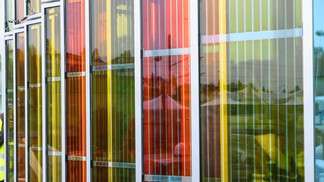EPFL's campus has the world's first solar window

EPFL's new convention center is being equipped with an impressive glass façade composed of dye solar cells. The first architectural integration of this technology is a new step in Romande Energie and EPFL's partnership to develop a large-scale solar park and conduct research and development projects.
Transparent, colored solar panels, fruits of the Graetzel cell technology, are currently being installed on the west façade of EPFL's future SwissTech Convention Center, scheduled to open its doors in April 2014. These 1,400 solar modules, each one 35 by 50 cm in size, will combine for a total surface area of 300 m2. The design, by artists Daniel Schlaepfer and Catherine Bolle, calls for 5 different shades of red, green and orange, giving the ensemble a warm, dynamic aspect.
This exterior solar window façade is a world first. The project leverages the potential of dye-sensitive solar cells known as Graetzel cells. In addition to being translucent, they're indifferent to the angle of incidence of light that hits them; they can be deployed vertically without any loss in efficiency. They not only produce renewable energy, but they also shade the building from direct sunlight, reducing the need for air conditioning. This innovative solar installation is funded by Romande Energie, and will be operational in December 2013.
A first for exterior architectural integration
Dye-sensitized solar cells, invented in 1991 by EPFL professor Michael Graetzel, reproduce the principles of photosynthesis in plants. The photovoltaic glass panel covering the west façade of the SwissTech Convention Center is the world's first exterior architectural integration of this cutting-edge technology. This visually compelling 300 m2 installation will be a demonstration of the potential of this kind of solar technology and the first step in their large-scale production and use.
Committed to research and development
"For us it's essential to support the emergence of innovative technologies that are directly related to what we do," says Pierre-Alain Urech, CEO of Romande Energie. Ten percent of the surface area of the Romande Energie – EPFL solar park, installed on the rooftops of the school's buildings, is dedicated to scientific research. Romande Energie is also participating in research projects on the evolution of electricity grids, electricity storage and the production of renewable energies.
This solar façade project is the culmination of a long-standing commitment to innovation and technology transfer at EPFL. No fewer than 11 companies have secured a license to market Graetzel cells.
This first architectural integration is all the more significant in that has been achieved via collaboration between Romande Energie, a key partner for EPFL in the field of energy. The partners are proud to present this realization, a showcase for the boom in renewable energy technology.
Provided by Ecole Polytechnique Federale de Lausanne




















